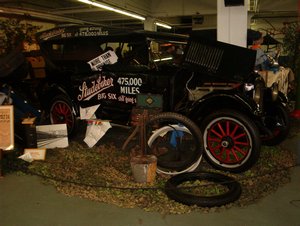















Studebaker Big Six |
|---|
|
| Topic Navigation |
|---|
|
Wikipedia: Studebaker Big Six
Page Sections History Photographs |
History
The following section is an excerpt from Wikipedia's Studebaker page on 5 April 2016, text available via the Creative Commons Attribution-ShareAlike 3.0 Unported License.
The Studebaker Big Six was an automobile produced by the Studebaker Corporation of South Bend, Indiana between 1918 and 1926, being designated the Model EG (1918–21), the EK (1922–24) and the EP (1925–26). In 1927, it was renamed the President (ES) pending introduction of a smaller and smoother straight-eight engine for new top-of-the-range models after January 1928.
Early models
All Studebaker models for 1918 represented an important milestone for the automaker because they represented a clean break from the legacy of E-M-F automobiles that Studebaker had been producing since the collapse of a less than successful marketing agreement.
Between 1918 and 1920, the Big Six was offered only as a four-door touring car, the most popular body style for automobiles at the time. But, as the price of enclosed cars came down and consumers discovered the benefits of closed and semi-closed passenger compartments, a wider variety of body styles was made available beginning with the 1921 model year. By 1926, the Big Six could be bought in a variety of specialty body styles including a dual-cowl Phaeton and a Berline (sedan).
1918 to 1919 Big Sixes were powered by Studebaker's 354 in³ (5.8-liter) Straight-6 engine that produced 60 bhp (45 kW) at 2000 rpm. By 1926, the engine was delivering 75 bhp (56 kW) at 2400 rpm. The car's wheelbase was varied between 1918 120 in (3,048 mm) and 1926 when the car was available in either short 120 in (3,048 mm) or long 127 in (3,226 mm) wheelbases.
1920s production
In the 1920s, twelve of the fourteen Arizona counties issued Studebakers to their sheriffs, because of their reputation for power, reliability, and ability to withstand hard use and bad roads. In 1925, the company published a pamphlet about the Arizona sheriffs' Studebakers, and named their Big Six Sport Phaeton model the Sheriff. One of the Arizona sheriffs' Big Six cars has been restored, and is on display at the Arizona Historical Society museum in Tucson.
At the 1924 New York Auto Show, Studebaker featured a 1918 Big Six that had a verified odometer reading of over 500,000 miles (800,000 km), as a testament to the longevity and durability of Studebaker vehicles.
Big Six President
In 1927, the model gained the transitional model name Big Six President as Studebaker began the process of converting all of its model names away from engine-type-based, and towards the more evocative Dictator (Standard Six) and Commander (Special Six). In the case of the Big Six President, 1928 would mark the introduction of Studebaker's famed 313-in³ Straight-8 which developed 100 bhp (75 kW) at 2600 rpm. The larger straight-six engine was utilised in the GB Commander before being replaced with a 248-in³ engine in 1929, marking the end of the line for the famous Big Six.
These sixes were the last descendants of rugged cars designed for poor roads in the early 20th century—loaded with torque and massively strong in construction. They were not suited to the higher cruising speeds which were made possible by better roads in later years.
| 1925 Big Six Duplex Phaeton Photo ©2016 Heidi Walczak View photo of 1925 Studebaker Big Six Duplex Phaeton at the Studebaker National Museum - 2.0MB | |
 |
475,000 mile car Photo ©2003 Heidi Walczak View photo of a Studebaker Big Six - 447KB |
